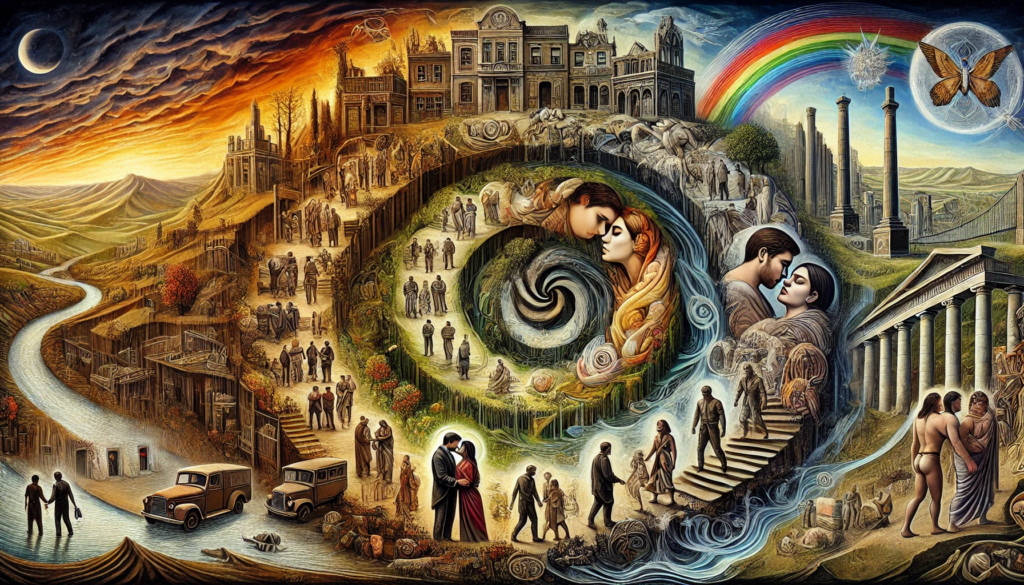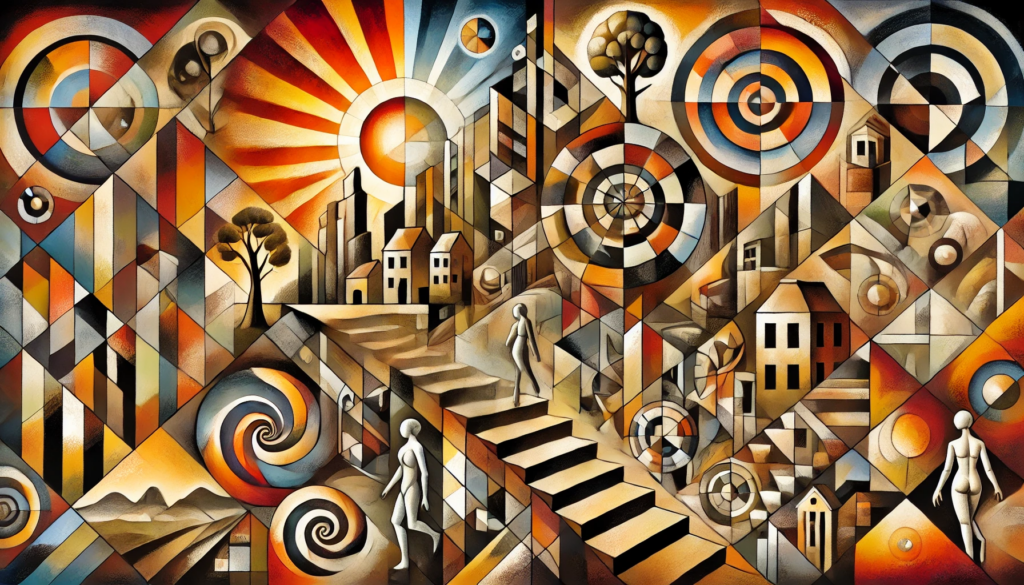
ChatGPT:
🌟 Expanded Summary of One Hundred Years of Solitude
Gabriel García Márquez’s One Hundred Years of Solitude is a masterwork of magical realism that captures the rise and fall of the Buendía family over seven generations. Set in the fictional town of Macondo, it intertwines personal lives with historical allegories, supernatural phenomena, and universal truths about human existence. Below is a detailed exploration of the novel’s rich narrative, key characters, and central themes.
🌿 The Founding of Macondo
The story begins with José Arcadio Buendía and his wife, Úrsula Iguarán, founding Macondo. They envision it as a utopian community, isolated from the outside world. José Arcadio, driven by curiosity and scientific ambition, becomes obsessed with alchemy and knowledge. His pursuits symbolize humanity’s yearning for progress but also lead to neglect and eventual ruin.
Macondo grows into a thriving community, attracting visitors like the gypsy Melquíades, who brings wonders such as magnets, ice, and a cryptic set of prophecies. These prophecies, written in Sanskrit, serve as a mysterious thread connecting the family’s destiny.
❤️ Love, Desire, and Relationships
The Buendía family’s history is marked by intense and often tragic love stories. Passionate romances, unrequited love, and incestuous relationships weave through generations.
• José Arcadio Buendía’s son, Colonel Aureliano Buendía, falls for the child bride Remedios Moscote, but their love is cut short by her untimely death.
• The ethereal Remedios the Beauty represents unattainable perfection and ascends to heaven in a miraculous event.
• Love is often tinged with obsession, as seen in Amaranta’s unrequited feelings for Pietro Crespi, which lead to bitterness.
These complex relationships illustrate the destructive and redemptive power of love.
⚔️ War and Political Turmoil
Colonel Aureliano Buendía becomes a revolutionary leader, embroiled in civil wars between Liberals and Conservatives. He leads 32 uprisings and loses them all, becoming increasingly disillusioned with politics and humanity.
The political conflicts mirror the historical struggles of Latin America, including cycles of war, corruption, and oppression. Despite his prominence, the Colonel’s legacy fades, reflecting the transient nature of power.
❄️ Solitude and Isolation
The novel’s title encapsulates its central theme: the inescapable solitude that haunts the Buendía family. Each character grapples with isolation in different forms:
• Emotional distance within relationships.
• Obsession with personal pursuits, like science, power, or love.
• The physical remoteness of Macondo itself.
Úrsula Iguarán is a stabilizing force, working tirelessly to preserve her family. Yet, she too succumbs to the inevitability of decline. Solitude becomes both a refuge and a curse for the Buendías.
🌟 Magical Realism and the Everyday Supernatural
Magical realism is a defining feature of the novel. Miracles and magical events occur alongside mundane life, creating a seamless blend of the extraordinary and the ordinary:
• Melquíades returns as a ghost to guide the Buendías.
• Remedios the Beauty ascends to heaven in front of astonished onlookers.
• Macondo experiences a four-year rainstorm and an invasion of yellow butterflies.
These elements symbolize the richness of Latin American culture and its integration of myth into reality.
🌀 The Cyclical Nature of Time
Time in One Hundred Years of Solitude is not linear but cyclical. Names, events, and behaviors repeat across generations. For example, characters are frequently named José Arcadio or Aureliano, and they often share traits and fates.
This cyclical pattern reflects the idea that humanity is doomed to repeat its mistakes unless it learns from them. The Buendía family fails to break free from this cycle, ultimately leading to their downfall.
🍌 The Banana Company and Colonial Exploitation
The arrival of the banana company brings prosperity to Macondo but also exploitation and violence. Workers are mistreated, and a brutal massacre occurs when they demand better conditions. This episode reflects real events in Colombian history, such as the 1928 Banana Massacre.
The company’s departure leaves Macondo in decay, symbolizing the destructive impact of colonialism and unchecked capitalism on Latin America.
📖 The Prophecy and the Family’s End
The cryptic prophecies of Melquíades, left unread for generations, are finally deciphered by the last Buendía, Aureliano. He discovers that the family’s history has been predetermined and that its destruction is inevitable.
In a cataclysmic conclusion, a hurricane obliterates Macondo, erasing it from existence. This apocalyptic ending fulfills the prophecy and underscores the novel’s themes of fate and the impermanence of human endeavors.
Themes and Symbolism
1. Solitude: Characters are isolated by their obsessions, choices, or circumstances.
2. History and Memory: The repetitive cycles of the Buendía family echo broader historical patterns.
3. Love and Desire: Passion is a driving force but often leads to destruction.
4. Colonialism: The banana company’s exploitation serves as a critique of foreign interference in Latin America.
5. Fate and Free Will: The family’s inability to escape its destiny raises questions about human agency.
Conclusion
One Hundred Years of Solitude is a sweeping epic that captures the complexity of human experience through the lens of one family. It masterfully combines magical realism, historical allegory, and universal themes to explore the cycles of love, ambition, and loss. The Buendía family’s tragic decline and Macondo’s ultimate destruction serve as a powerful reminder of the fragility of human endeavors and the inevitability of endings.
Quotes
1. “Many years later, as he faced the firing squad, Colonel Aureliano Buendía was to remember that distant afternoon when his father took him to discover ice.”
• This opening line sets the tone for the novel, blending memory, destiny, and magical realism.
2. “It’s enough for me to be sure that you and I exist at this moment.”
• A poignant statement on the fleeting nature of existence and the importance of living in the present.
3. “There is always something left to love.”
• A central theme of resilience and human connection despite adversity.
4. “Things have a life of their own. It’s simply a matter of waking up their souls.”
• A reflection of the novel’s magical realism, emphasizing the vitality of even inanimate objects.
5. “A person doesn’t die when he should but when he can.”
• A somber observation on death and the unpredictability of life’s end.
6. “The world was so recent that many things lacked names, and in order to indicate them it was necessary to point.”
• A description of Macondo’s mythical beginning and the purity of its origins.
7. “He really had been through death, but he had returned because he could not bear the solitude.”
• A powerful exploration of solitude as both a curse and a driver of human actions.
8. “What matters in life is not what happens to you but what you remember and how you remember it.”
• A reflection on memory as a key theme of the story.
9. “Races condemned to one hundred years of solitude did not have a second opportunity on earth.”
• The prophetic conclusion of the novel, tying the Buendía family’s fate to larger human struggles.
10. “Macondo was already a fearful whirlwind of dust and rubble being spun about by the wrath of the biblical hurricane.”
• A vivid depiction of the town’s ultimate destruction.

FAQs
Q: What is the main theme of One Hundred Years of Solitude?
A: The main theme is the cyclical nature of history and human experience, as reflected in the lives of the Buendía family. Solitude, love, fate, and the passage of time are also central themes.
Q: What is magical realism, and how is it used in the novel?
A: Magical realism combines the ordinary with the supernatural, treating fantastical events as part of everyday life. In the novel, this is seen in events like Remedios the Beauty ascending to heaven and Macondo’s four-year rainstorm, which symbolize deeper truths about life and culture.
Q: Who are the Buendías?
A: The Buendías are the central family of the novel. Over seven generations, their lives reflect the struggles, passions, and flaws of humanity, ultimately leading to their downfall. Each generation repeats patterns of ambition, love, and solitude.
Q: What role does Macondo play in the novel?
A: Macondo is the fictional town where the story takes place. It serves as a microcosm of Latin America, reflecting its history, culture, and struggles, from its founding to its eventual destruction.
Q: What is the significance of Melquíades’ prophecies?
A: Melquíades’ cryptic manuscript foretells the fate of the Buendía family and Macondo. It symbolizes the inevitability of destiny and the cyclical nature of time, as the family fails to change its preordained path.
Q: How does the novel address Latin American history?
A: Through allegory, the novel mirrors Latin America’s colonial history, political upheavals, and societal transformations. The arrival of the banana company, for instance, reflects the exploitation and violence of foreign interventions.
Q: Why is solitude such a prominent theme?
A: Solitude symbolizes the emotional and existential isolation faced by the Buendías. Despite their relationships, each character struggles with internal loneliness, which often drives their actions and leads to their demise.
Q: What is the role of women in the novel?
A: Women like Úrsula Iguarán play pivotal roles as caretakers, moral centers, and survivors in the Buendía family. Despite their strength, they too are affected by the family’s cyclical tragedies.
Q: Why does the novel have a non-linear structure?
A: The non-linear structure emphasizes the cyclical nature of time and history. Events repeat, names recur, and the narrative loops back on itself, reinforcing the theme of inevitable repetition.
Q: How does the novel end?
A: The last Buendía, Aureliano, deciphers Melquíades’ manuscript, realizing the family’s fate is sealed. A hurricane destroys Macondo, erasing it from existence and completing the cycle of history.
********
One Hundred Years of Solitude has been widely acclaimed, but like any literary masterpiece, it has also faced criticism. Here are some notable critics and their concerns:
1. Harold Bloom
• Critique: While acknowledging the novel’s brilliance, Bloom criticized its reliance on magical realism, suggesting it could detract from the universal truths within the story.
2. Mario Vargas Llosa
• Critique: A contemporary of García Márquez, Vargas Llosa appreciated the novel but argued that its heavy use of allegory sometimes overshadowed the individuality of its characters.
3. Ángel Rama
• Critique: As a literary critic, Rama pointed out that the novel’s portrayal of history through magical realism might dilute the urgency of real-world political struggles.
4. Gerald Martin
• Critique: In his biography of García Márquez, Martin explored how the novel’s commercial success sometimes led to it being misinterpreted as a purely “fantastical” work rather than a deep political commentary.
5. Feminist Critics
• Critique: Some feminist scholars argue that while women like Úrsula Iguarán are portrayed as strong, the novel still reinforces patriarchal norms by centering the narrative on male characters and their legacies.
6. Marxist Critics
• Critique: Marxist interpretations suggest that García Márquez’s depiction of capitalist exploitation (like the banana company episode) is powerful but lacks a direct call to action against systemic oppression.
7. Postcolonial Critics
• Critique: Some postcolonial theorists assert that the novel’s magical realism can obscure the real impacts of colonialism and imperialism, romanticizing rather than confronting them.
8. Gabriel Zaid
• Critique: Zaid, a Mexican critic, argued that the novel’s overwhelming popularity risked making García Márquez a “one-book author,” with his other works often overshadowed.

